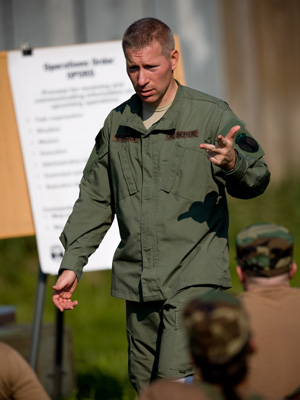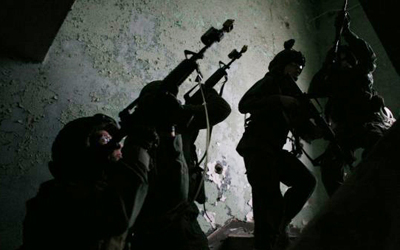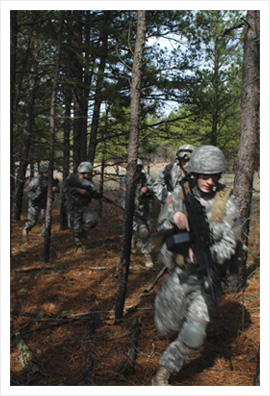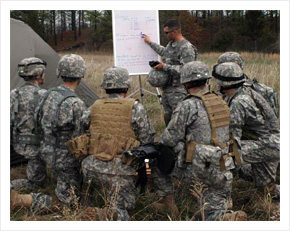IPB Military Unit Symbols – Part I
Why We SHOULD ‘Play Army’!
Force-on-Force Training
The Bayonet – Obsolete?
The Law for the Wolves
Military Unit Types & Sizes
Beyond the Square Range
I find myself watching videos on YouTube again. Most of the time it points me towards videos of firearms training or competition. Not surprising since that is one of my interests. I’m always amazed how proficient the top competitors are. Whether it’s IDPA, IPSC, or 3-Gun, I usually end up finding videos where my jaw hits the floor. The speed and accuracy they are able to achieve is absolutely mind-boggling. As an occasional competitor myself, I can certainly appreciate the level of training and dedication it took to get where they are.
The tactical trainers are just as impressive. The biggest difference of course, is they generally demonstrate their skill while wearing more practical and tactical equipment. There are no race guns; no special shot shell loaders – just practical firearms and equipment.
There is something amazing about watching a Steel Challenge shooter hit 5 plates scattered about in just a few seconds. Watching guys decked out in full armor punch out of a vehicle blasting an array of steel targets while flash-bangs go off is just down right cool.
However, what I like about these videos is also what I despise. Is this what the peak of firearms training looks like? Well, why shouldn’t it be? These people are international champions – quite literally Grand Masters at what they do. The tactical trainers are often combat veterans, guys who have been there and done that. Of course we can learn something from them. But to what end?
If competition is your bag, then its obvious that path of training will lead you to a level of marksmanship and speed unlike any other game in firearms. Yes – game. I don’t mean that as a pejorative. Not at all. Really. It’s perfectly okay to be a professional baseball player. Why shouldn’t it be okay to be good at a game involving firearms?

I know what some of you are thinking. I agree that there are skills that can be learned from competition that can apply to a real world gunfighting situation. However, it’s not difficult to see that its a game. First, there are rules. The targets don’t shoot back. They behave predictably. The majority of the time, the competitor is allowed to walk the course. They get to know where all the targets are, where to stand, what target activates movement on another target. They get to plan their round count and at exactly which moment they will reload. It’s fairly clear this a game.
Now the tactical trainers seem to approach things a bit differently. Most of what I’ve seen focuses around a series of drills. Drills aren’t bad. Drills are good. They allow us to refine those tactile skills necessary to become a good shooter. But again to what end? It seems as though most trainers would have you believe that their culmination exercise or evolution is the moment where the purpose of their training becomes clear. Is it? By no fault of their own, most customers are led to believe so.
I’ve seen too many videos in which a shooting skill is applied by placing the shooter in a scenario where they are told to conduct a battle drill – without ever explaining the purpose of the battle drill. Neither do they explain the decision matrix. In short, they don’t tell the shooter why they are there or what they must assess.
Unfortunately, the result is a shooter who has a warped understanding of gunfighting and patrolling. No one second guesses why they are to engage and advance towards an overwhelming force of paper and steel targets in the middle of an open field all the while transitioning to pistols and clearing malfunctions with only the non-dominate hand. That is a poor tactical decision and is not an accurate representation of a gunfight at all.
I’ll suggest that is analogous to teaching someone who knows nothing of baseball how to hit a grand slam one-handed in the last inning of the World Series. It’s absurd.
In the shooting scenario above, wounded and hopelessly outgunned, my battle buddy and I would break contact and seek a new angle of attack. Anyone who would think otherwise is a grossly irresponsible leader that I wouldn’t follow. Don’t try to sell me a highly specialized skill as if it were a standard skill set of gunfighting.
Don’t get me wrong. I am not implying that instructors are intentionally negligent or malicious. For them, I imagine it is the best way they know to push shooting skills to the point of failure. It makes sense to create a high stress environment to test student manipulation skills and marksmanship. Yet unknowingly these instructors are providing a severe disservice. Students may walk away with unreasonable expectations of such unorthodox skills.
What is needed is a better contextual understanding of where and how these skills might apply. In order for that to happen battle drills need to be taught and understood – immediate action battle drills like hasty attack, break contact, and react to ambush. The problem is, that doesn’t sell.
People come to shoot their rifles. Most of the training is done in a classroom setting and square, one-directional range. In the “wowee” appeal of stress shooting, students are left with a unrealistic idea of gunfighting and tactics in general.
It is said that amateurs worry about tactics, while professionals worry about logistics. I think there is something to that sentiment.
Allow me to stretch that model into the current topic to suggest that amateur shooters worry about hitting the mark, while professional shooters worry about training objectives.
If we concern ourselves only with weapon manipulation and shooting skills, an admittedly a small percentage of warrior tasks and competencies, then we’re fooling ourselves. We’re putting people in scenarios without any regard for contextual understanding. As instructors we’ve then failed our students because we’ve established unrealistic gunfighting expectations for our students without teaching the warrior competencies of situational awareness and decision-making.
Always ask why. If your instructor cannot explain the context of the problem and its decision points – its time to find a new instructor.
This article was originally published on odjournal.com (Olive Drab: the journal of tactics) and has been transferred here with permission.
Full Spectrum Training: Which conflict…this one, or the next?
A warrior who picks up too many stones, soon drops all of them. – Native American proverb
I’ve heard the grumbling for a handful of years now. This mild dissention is understandable. An artillery captain in the 10th Mountain Division at Ft. Drum, NY tells me his troops train so little on their guns that they can barely pass their firing battery.
Two NCO squad leaders serving in the 3rd Infantry Divisions at Ft. Hood, TX complained that their troops no longer train for dismounted patrols. They insisted that many Soldiers pull four years of service and never again put on face camouflage after they complete the School of the Infantry.
 Another periodical recently printed a story titled “Is Ranger School still relevant?” Not surprisingly the active-duty Soldiers offering expert perspectives eventually opined that yes, Ranger School is still relevant and necessary. But they were quick to agree that after ten years of war, few Soldiers required any particular school for promotion points – or even to improve the way they conduct the business of prosecuting the current wars. Indeed, one Ranger insisted that the unique focus on dismounted patrolling operations during Ranger School seemed a bit of an anachronism in light of today’s mechanized and motorized urban operations.
Another periodical recently printed a story titled “Is Ranger School still relevant?” Not surprisingly the active-duty Soldiers offering expert perspectives eventually opined that yes, Ranger School is still relevant and necessary. But they were quick to agree that after ten years of war, few Soldiers required any particular school for promotion points – or even to improve the way they conduct the business of prosecuting the current wars. Indeed, one Ranger insisted that the unique focus on dismounted patrolling operations during Ranger School seemed a bit of an anachronism in light of today’s mechanized and motorized urban operations.
The question as to where training should be focused is an important one. I certainly don’t mean to make light of it. Yet each time this conversation comes up, I’m reminded of something my mother said years ago about the women’s liberation movement. A former newspaper editor and field archivist for the State of Missouri, she insisted, “A woman can have it all! She can be a student, mother, wife, lover, professional, home keeper, educator and green-thumb in her own garden. But not all at one time. No one can wear that many hats at once. It takes a lifetime.”
Perhaps there is wisdom in this approach to training for the full spectrum of military operations.
Full Spectrum Operations (FSO) might best be described as a continuum from sustainable peace to total warfare between to industrialized states or non-state antagonists. Our Armed Forces train for each phase of that continuum. Why? Because the separate phases are not static, that is, each phase can quickly escalate up to a higher level of violence, or it may ratchet down in conflict toward a steadier and sustainable peace. Our Soldiers, Marines, Airmen and Sailors are expected to perform competently and professionally in all phases of FSO.
Although there are numerous phases and even hybrid phases of FSO, it might be easier to think of it in a four-phased continuum – Kinetic Operations, Counterinsurgency, Stability Operations, and Peace Operations.
Kinetic Operations
This is maneuver warfare in its most advanced form. It might entail “total war” between two or more industrialized nations such as the last world war when militaries bombed entire cities of their enemy. In more recent years it has at least been the means by which one military gains entrance into another region or state, such as the United Nations coalition during the Persian Gulf War.
 Counterinsurgency
Counterinsurgency
Along with Kinetic Operations (KO), counterinsurgency (COIN) makes up what we think of a “traditional” military operations. Under the definition of COIN falls a wide variety of conflict, from internal insurgencies and counterinsurgencies, to border conflicts and infiltrating forces meant to disrupt the legitimate government. Such conflicts may occur both with or without the help of Foreign Internal Defense (FID) from another nation, coalition or cause.
Stability Operations
In the wake of either KO, COIN or even natural disaster, Stability And Reconstruction Operations (SARO, formerly SASO) conduct every conceivable mission from transportation and security support to humanitarian refugee relief, to political election support, to economic reconstruction under such Other Government Agencies (OGA) as US Department of State Provincial Reconstruction Teams (PRT) and Non-Government Agencies (NGA) like the International Monetary Fund (IMF). SARO becomes an alphabet soup of agencies and organizations attempting restore sustainable peace, health and prosperity to a damaged region or nation.
Clearly the US military takes something of a backseat as shaping and sustaining operations during SARO, and allows NGO/OGA to take the lead on the decisive operations. Yet this sort of unfathomable coordination requires substantial training.
Peace Operations
If any time during SARO and COIN stability is lost to unrest, the situation may quickly escalate to KO. In general terms that level of violence is perceived to be a unacceptable outcome. And even though in the short run KO might remove a dangerous adversary, violence is not sustainable indefinitely. In short, the solution requires more than just military might.
The implied strategic objective then is to move toward Peace Operations (PO). Along with SARO, PO makes up what is called Military Operations Other Than War (MOOTW, pronounced “moo-twah”), to use the proper vernacular.
Yet PO, too, is very complicated and takes many forms. Peacekeeping, for example, involves the use of foreign troops to a region or nation when one or more of the adversarial parties invites said peackeepers in. This is quite another matter from Peace Enforcement whereby the foreign military forcibly enters the region to put down violent unrest.
Peacekeepers are highly regulated and highly limited in terms of their mission as well as their rules of engagement (ROE). After all, they have been invited into the region for specified task. Peace Enforcement has considerably less limitation on its mission or ROE, and so tends to see more immediate results. By way of example, consider the depressingly ineffective United Nations Peacekeeping mission to Bosnia in the early 1990s, compared to the very effective NATO Peace Enforcement in Bosnia just four years later.
Again, whether we’re talking traditional military operations such as KO and COIN, or MOOTW such as SARO and PO – each of these missions require careful preparation and training on the part of our military.
Why train for MOOTW missions? Because if we instead enter these endeavors half-heartedly we slip into what is colloquially called mission creep that ends in debacles such as the 1983 Beirut Bombing or the 1993 Battle of Mogadishu. Our military force loses its focus and finds itself engulfed in quagmire.
Yet with training, our military enjoys the prestige and confidence of successful operations such as in Banda Aceh, Indonesia after the devastating natural disaster of a tsunami. Too, we’ve enjoyed recent successes in quelling the conflicts in Bosnia and Kosovo while seeking workable solutions.
The Current Priority
So where are we today? Policymakers have clearly and perhaps wisely chosen to address the conflict we’re facing right now, immediately.
This means that the focus is now on the various missions lower on the FSO continuum, being COIN, SARO and PO. Indeed, other than future weapon development projects that continue to see their budgets cut, little effort at all has been placed on training for KO. Funding for curriculum development, training facility and training schedules have all but turned their back on traditional warfighting skill sets.
Frustrations due to this policy are felt all the way around. Leaders within the theaters of operation demand less funding for future stealth technology for the Navy and Air Force, and more funds to prosecute the development of their Areas Of Responsibility (AOR). Likewise, career Soldiers understand that the Contemporary Operating Picture (COP) is a temporary snap shot in time. It has changed in recent years, and will change again soon enough. They want to divide the resources in order to achieve some semblance of balance in training for FSO.
It’s easy to appreciate the argument. It’s much more difficult to employ a solution that satisfies everyone.
On one hand, we have the historic image of the numerically superior French army at Agincourt. They were excellent at waging battle with their heavy cavalry, virtually unbeaten until that October day in 1415. Unwilling to recognize that the battle in front of them had changed drastically with the introduction of the English longbow archer, the French continue to fight the fight they wanted rather than to do what was necessary to win! And of course it ended disastrously for the French.
On the other hand, we have the historic image of waning Roman Empire and the relaxing of the standards for its once powerful and capable Legions. Once the sharpness of its armies were lost, so too were the Empire’s diplomatic and economic forms of coercion. Soon after, Rome itself would fall to invasion at the hands of more powerful armies.
While no nation lasts forever, not even the great social-political experiment called the United States of America, prudence might suggest we employ the wisdom of our elders. Just as no woman can be all things to all people at a single point in time, perhaps no military is meant to handle the entire spectrum of conflict at a single point in time.
My colleagues over at Gun Control International (http://guncontrolintl.com), a weapon skills training company that hosts exchange training courses with One Shepherd, has a simple motto: “Training is not an option. It is a way of life.”
I appreciate that sentiment because it suggests that there is no pinnacle peak to reach in training. There is no time or place or measure that we come to as warriors where we can say, “Okay, now I know enough to stop learning.”
Training is an ongoing lifetime pursuit. We train for the conflict at hand, first and foremost. We also build training for future conflicts. And if we’re very clever in our training programs, we’re careful not to unlearn the lessons of our past conflicts.
This article was originally published on odjournal.com (Olive Drab: the journal of tactics) and has been transferred here with permission.
Failure in Training
 I’m riding across Missouri with four members of One Shepherd’s staff, headed to a 3-day immersive field exercise. Invariably the war stories start flying – as that is the birth right of all troops. And this is good because war stories often turn into lofty discussions of what went wrong and how to fix it.
I’m riding across Missouri with four members of One Shepherd’s staff, headed to a 3-day immersive field exercise. Invariably the war stories start flying – as that is the birth right of all troops. And this is good because war stories often turn into lofty discussions of what went wrong and how to fix it.
One instructor expresses dismay for a local SWAT team that had failed a tactical exercise a couple years back. To hear this instructor tell the story, the SWAT officers were tactically adept in live fire drills and weapon manipulation. Their marksmanship was impressive and they gave every impression of being disciplined professionals. However, everything seemed to fall apart when the SWAT team asked a couple of well-established paintballers to act as OPFOR for their force-on-force (FoF) exercise.
The FoF exercise was set in an old manufacturing plant with a maze of rooms and hallways. It was a big task to begin with, but with 42 officers it was do-able. Besides, the exercise scenario called for just two “gunmen” on a rampage. The One Shepherd instructor was, of course, one of the two paintball gamers invited to act as the crazed gunmen in the scenario. And he admitted that most of the SWAT officers were new to paintball markers, with just a few being experienced paintballers.
What happened next was a complete route. SWAT entered the building in good form and began to clear rooms using proper doctrine and tactics. Very uniformed, very disciplined. Yet as the OPFOR gunmen began to attack, just two gunmen eliminated multiple teams of SWAT. The controllers stopped the scenario and everyone, including the OPFOR thought it was just a fluke. On the spot corrections were given and the scenario proceeded – horribly.
The second scenario proved even worse than the first. The controllers refused to stop the scenario insisting that the SWAT officers would need to learn to adapt and overcome their opponent’s tactics. The end result was that more than 30 SWAT members were eliminated before the two paintballers simply ran away, untouched by paint.
A third iteration of the SWAT scenario finally ended with the paintballers being casualties, but again only after conducting multiple suicide charges that initially ended in complete, unabated success for the two-man suicide team! Again, it produced similarly lopsided casualties against the SWAT team before the two paintballers were shot.
Fast-forward a couple of years and one of the paintballers is now an instructor for One Shepherd. The experience unnerved him then, and it dominates our discussion because he is now concerned that his students might fall into that same trap – strict adherence to tactical doctrine. Furthermore, he admits he is still confused as to what went wrong for the SWAT team.
So what did go wrong?
Perhaps nothing. First and foremost I’ll insist that training should create a safe place to fail. Training scenarios are not to be used as competition or punishment. Failure is desirable. It produces the best learning if proper, solution-focused reflection is employed. In fact, as long as the students are attempting to find solutions to the problem, failure should be encouraged.
Now clearly at a tactical level something was drastically wrong. Forty-some-odd SWAT officers should be able to subdue and/or eliminate two mad gunmen. I don’t care how drugged-up, armored-up, or talented the gunmen are!
I’d suggest the issue of weapon manipulation is paramount here. It’s no small concern. This battle was up close and personal, conducted at a few mere meters between opponents. Fumbling with an unfamiliar weapon system leaves your opponent precious few moments to gain the upper hand. If you’re accustomed to one weapon platform and are handed another for which you’ve never been trained…well, expect disastrous things.
The fix is easy enough to identify. Train on the weapon systems you will use. If you employ live fire with firearms, train on that exhaustively. If you then employ a simulation system (paintball marker in this case) for FoF training, be sure to train on that weapon system until everyone is flawlessly proficient!
 Another issue is problem solving with tunnel vision. Such as, “I’m using a paintball marker; therefore I must solve all the problems in this scenario with a paintball marker.”
Another issue is problem solving with tunnel vision. Such as, “I’m using a paintball marker; therefore I must solve all the problems in this scenario with a paintball marker.”
I don’t know about you, but if my weapon went black in a hallway with armed opponents just meters away, I would be clubbing my opponent into submission with said defective weapon!
There doesn’t seem to be much wrong with the scenario, per se. The problem apparently is that the SWAT officers were not employing creative problem solving. I asked the One Shepherd instructor if the officers had any tape, plastic, netting or even office furniture. “Why?” he shot back. Well, to barricade the doors and hallways so as to slow, kill, or capture the gunmen. I explained that tape also offers a quick visual for marking already searched rooms. The light above his head went on.
“Oh. So you don’t necessarily have to shoot the enemy,” he said, thinking out loud.
You need to solve the problem. If that means using your weapon, then so be it. If it means setting fire to part of the structure to either deny its use to the enemy or force them out into prepared engagement areas, then so be it. And yes, as crazy as it sounds, if I can whip up a spider web of 100mph tape and zip up the bad guy as he runs down the hallway, then sure. Why not?
The point is that training scenarios should offer the opportunity to problem solve. And by creating a safe place to fail, we encourage creative problem solving. Failure is good. It’s a critical part of the training methodology in that it offers an opportunity for reflective thinking and the generation of new possible solutions to the problem.
Course it never hurts to know your weapon.
This article was originally published on odjournal.com (Olive Drab: the journal of tactics) and has been transferred here with permission.